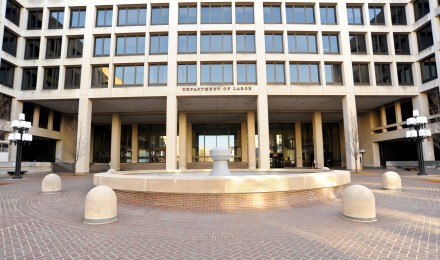Jobless claims data show that the number of Americans filing initial applications for benefits increased at a slower pace than expected. For the week ended September 14, the number rose 15,000 to 309,00 from a revised 294,000 the prior week. The 53 economists responding to the Bloomberg survey gave estimates that spanned from 310,000 to 360,000 for a median of 330,000.
According to a Labor Department spokesperson, California and Nevada continue to play catch-up as they work through a log jam of claim applications. A problem occurred with computer updates. It may be another two weeks to work through the buildup of claim applications.
Jobless claims report data
The four-week moving average, which smooths out the volatility in weekly numbers, dropped to the lowest level since October 2007 at 314,750. In total, fewer people are receiving jobless claims benefits. This measurement declined 28,000 to 2.79 million Americans for the week ended September 7.
Persons receiving help under the extended and emergency programs, which are sponsored by the federal government, remains at 1.46 million individuals for the week ended August 31.
For the week ended September 7, the unemployment rate among Americans qualified to receive unemployment benefits fell to 2.1 percent from 2.2 percent.
Initial claims dropped in 44 states and territories and 13 registered an increase.
Labor market improving
Today’s data may signify a labor market that is beginning to make some headway this month. Millan Mulraine, an economist at TD Securities- New York, said , “This report paints a very encouraging picture on the job separation side of the labor market, which continues to see signs of sustained improvement.
With due consideration to the technology issues, fewer job layoffs foreshadow larger hiring gains. Putting more people to work leads to growth in consumer spending., which accounts for more than two thirds of the nation’s economy
Brian Jones, the senior U.S. economist at Societe Generale (New York) also sees a strengthening labor market. “Even if they’re working through the backlog, these numbers seem to have a little bit more behind them than just processing problems,” said Jones.
Fed’s September surprise
The decision by the Federal Reserve to leave its $85 billion a month bond-buying program was unexpected. This seems to be in keeping with its original intention for the quantitative easing initiate–to boost the economy and bring down the unemployment rate. “Labor market conditions have shown further improvement in recent months, on balance, but the unemployment rate remains elevated,” according to a statement released by the Federal Open Market Committee (FOMC).
A run of mixed economic data released just before the conclusion of the Fed’s meeting on Wednesday , and concerns expressed by policymakers may have been enough to deter the FMOC from making cuts in the program.
Annalisa Piazza, an analyst at Newedge Strategy says that the recent Employment Situation data may have been enough to put cut backs on hold. The report shows that the average number of jobs created in the last few months actually dropped below the 12-month average for new hiring.
Jobless claims data show that the number of Americans filing initial applications for benefits increased at a slower pace than expected. For the week ended September 14, the number rose 15,000 to 309,00 from a revised 294,000 the prior week. The 53 economists responding to the Bloomberg survey gave estimates that spanned from 310,000 to 360,000 for a median of 330,000.
According to a Labor Department spokesperson, California and Nevada continue to play catch-up as they work through a log jam of claim applications. A problem occurred with computer updates. It may be another two weeks to work through the buildup of claim applications.
Jobless claims report data
The four-week moving average, which smooths out the volatility in weekly numbers, dropped to the lowest level since October 2007 at 314,750. In total, fewer people are receiving jobless claims benefits. This measurement declined 28,000 to 2.79 million Americans for the week ended September 7.
Persons receiving help under the extended and emergency programs, which are sponsored by the federal government, remains at 1.46 million individuals for the week ended August 31.
For the week ended September 7, the unemployment rate among Americans qualified to receive unemployment benefits fell to 2.1 percent from 2.2 percent.
Initial claims dropped in 44 states and territories and 13 registered an increase.
Labor market improving
Today’s data may signify a labor market that is beginning to make some headway this month. Millan Mulraine, an economist at TD Securities- New York, said , “This report paints a very encouraging picture on the job separation side of the labor market, which continues to see signs of sustained improvement.
With due consideration to the technology issues, fewer job layoffs foreshadow larger hiring gains. Putting more people to work leads to growth in consumer spending., which accounts for more than two thirds of the nation’s economy
Brian Jones, the senior U.S. economist at Societe Generale (New York) also sees a strengthening labor market. “Even if they’re working through the backlog, these numbers seem to have a little bit more behind them than just processing problems,” said Jones.
Fed’s September surprise
The decision by the Federal Reserve to leave its $85 billion a month bond-buying program was unexpected. This seems to be in keeping with its original intention for the quantitative easing initiate–to boost the economy and bring down the unemployment rate. “Labor market conditions have shown further improvement in recent months, on balance, but the unemployment rate remains elevated,” according to a statement released by the Federal Open Market Committee (FOMC).
A run of mixed economic data released just before the conclusion of the Fed’s meeting on Wednesday , and concerns expressed by policymakers may have been enough to deter the FMOC from making cuts in the program.
Annalisa Piazza, an analyst at Newedge Strategy says that the recent Employment Situation data may have been enough to put cut backs on hold. The report shows that the average number of jobs created in the last few months actually dropped below the 12-month average for new hiring.







